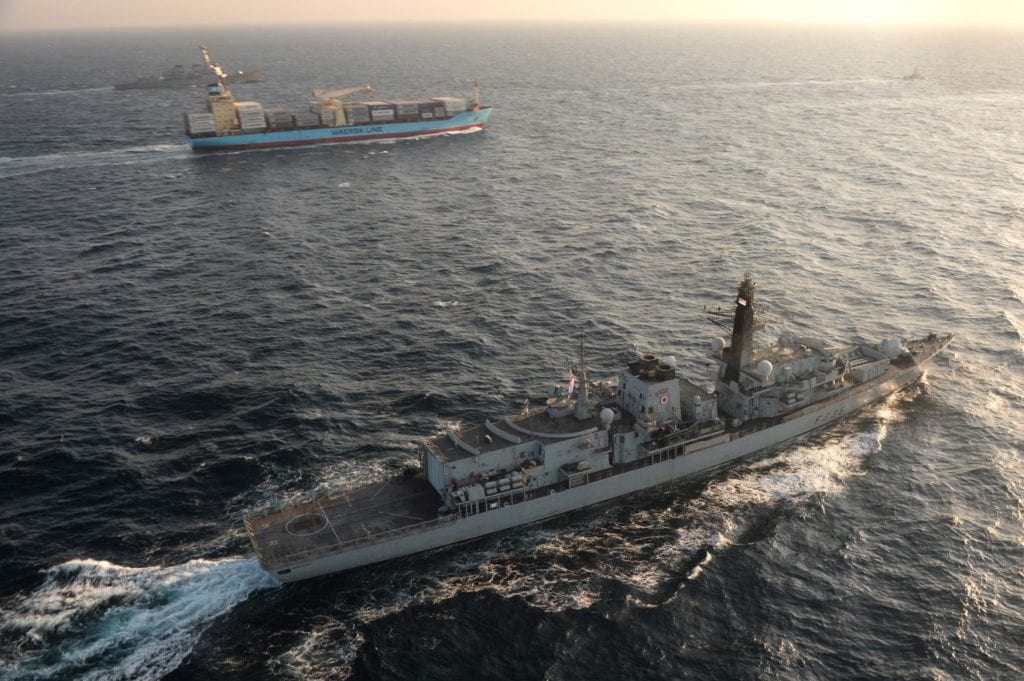
Collaboration between the merchant shipping community and coalition military forces is critical in securing maritime trade flows across the Middle East region, with communications and information sharing central to such collaboration, a U.S. Navy officer told a recent regional shipping stakeholder conference.
“Events have made it clear that no one entity alone can provide assurance to merchant shipping in this region,” Capt. Todd Hiller, commanding officer of Bahrain-based Naval Forces Central Command’s (NAVCENT’s) Naval Cooperation And Guidance for Shipping (NCAGS) organization, told the annual International Maritime Security Construct (IMSC) conference last month. “Never before has it been more important to collaborate with our coalition partners and stakeholders to protect freedom of navigation in this critical part of the world.”
Established in 2019 following attacks on commercial ships in port and at sea, IMSC is a multinational maritime coalition designed to deter “gray zone” threats to commercial shipping operating between the Southern Red Sea and the Northern Gulf. The 2021 conference, titled Security through Partnership, was IMSC’s second annual event, held virtually due to the Covid-19 pandemic.
While IMSC-led naval presence has done much to deter attacks, risk persists. “From unmanned vessel-borne improvised explosive device attacks, to limpet mines attached to the hulls of tankers, to the recent seizure of the Motor Tanker Hankuk Chemi … these threats continue to attempt to destabilize commercial shipping,” Hiller said.
“Given the high risk of navigating, and security interests in the Middle East, there has been a steady uptick in stakeholder involvement in information sharing,” he said. “More times to not, stakeholders and coalition partners have shared specific knowledge and expertise that is paramount in staying ahead of the [risk].”
NCAGS acts as a key node in such information sharing, Hiller said. “NCAGS is an organization that bridges the gap between sustainment of forward-deployed military forces and merchant shipping, by providing a framework for communicating directions, advisories, concerns, and information. The mission is to assist the [U.S. 5th] Fleet commander in managing risk by providing maritime domain awareness (MDA), real-time clarity of the merchant shipping picture, and ensuring safe passage of merchant shipping in crisis or contingency.”
Staffed by U.S. Navy reservists, many of whom are merchant mariners or strategic sealift officers, NCAGS can scale up from providing single personnel as merchant marine advisors or liaison officers ashore or at sea, to a large theater contingent providing a shipping coordination center with teams assigned ashore or at sea.
Effective communications and information sharing is two way, Hiller said. For NCAGS, its outputs include creating incident reports, conducting ship visits, recommending transit routes, providing subject matter expertise, sharing best practice (currently based around the stakeholder-produced Best Management Practice document, or BMP 5), supporting NAVCENT forces and building and sharing an overall MDA and “pattern of life” picture. NCAGS is a touchpoint for shipping, for example for vessels transiting high-risk regions like the Southern Red Sea or the Straits of Hormuz. In return, the shipping community shares ship, cargo, and voyage information with NCAGS and encourages vessel masters to follow BMP5 guidance and report incidents to help build MDA.
“[Sharing] the most current information and accurate assessment of the merchant shipping picture is critical to the establishment of the ‘pattern of life’ and the achievement of MDA,” Hiller said.
From NCAGS’ perspective, effective communications and information sharing are enabled by its monitoring, tracking, and wider information technologies.
“Staying ahead with the latest information technology will keep NCAGS ahead of adversaries and reduce risk as it relates to operations, monitoring and surveillance, piracy, war, or other risks that could potentially impact MDA and patterns of life within the region,” Hiller said.
Hiller told Seapower that NCAGS information technologies include AIS Live and the SeaVision web-based maritime situational awareness tool, and that it is procuring the Maritime Intelligence Risk Suite tool that combines shipping database, real-time ship tracking, and risk event information.
- UK Chief of Defence Staff Highlights Maritime Context Within Defense Review Refresh - December 21, 2022
- Naval Stakeholders Assess Lessons Learned from Ukraine Conflict for Future War at Sea - October 24, 2022
- NATO Uses Unmanned Systems Exercises to Stay Ahead in Capability Development - October 10, 2022






